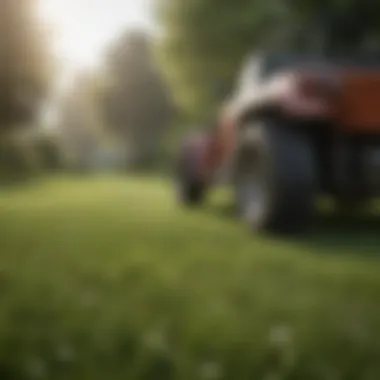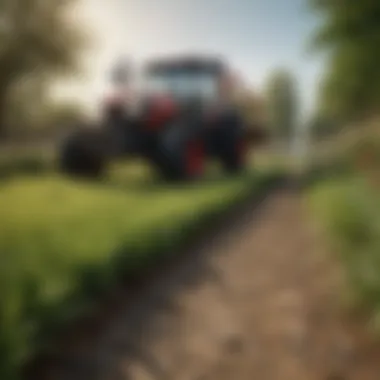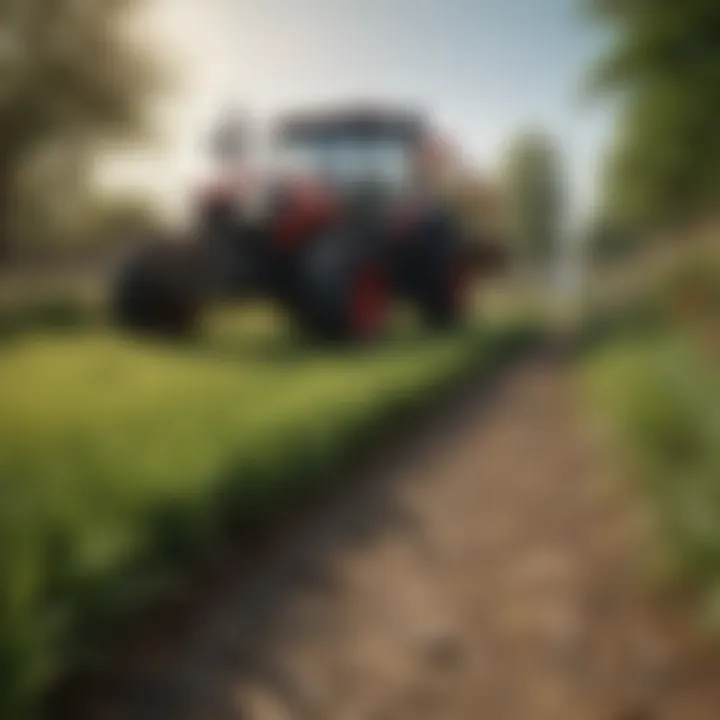Granular Pesticides for Lawns: An In-Depth Guide


Intro
Maintaining a healthy lawn can be a challenge for any homeowner. Pests can quickly turn a beautiful green space into a patchy nightmare. Granular pesticides are one of the several tools available for effective lawn care. Understanding their advantages, ingredients, and proper application is essential for successful pest management. This guide will navigate through all aspects of using granular pesticides for lawns.
Pest Identification
Identifying pests correctly is the first crucial step in maintaining a healthy lawn. Different pests present unique challenges, and understanding their presence can help in determining whether a granular pesticide is needed.
Detailed Descriptions of Common Pests
Common pests that affect lawns include:
- Grubs: These pests are the larvae of beetles. They feed on grass roots, causing brown patches in the lawn.
- Chinch Bugs: Known for their saliva, which damages grass blades. They tend to thrive in warm weather.
- Armyworms: These caterpillars can decimate a lawn in a short time. They are usually visible in late summer.
- Turf Lecters: Small pests that create brown spots in the lawn. Their presence requires immediate attention.
Signs and Symptoms of Infestations
Recognizing the signs of an infestation is vital. Common indications include:
- Yellowing or browning of grass
- Increasing patches of dead grass
- Presence of insect activity (i.e., visible grubs or other pests)
- Uneven growth patterns in the lawn
Prevention Strategies
Preventing pests from invading your lawn is often the best strategy. Simple maintenance practices can make a significant difference.
Home Maintenance Tips for Pest Prevention
- Regular mowing of grass helps maintain its health.
- Aerate the lawn to improve water and nutrient absorption.
- Maintain proper watering schedules — overwatering can attract pests.
- Avoid excessive thatch buildup, which can serve as a habitat for pests.
- Rotate your lawn care routines to discourage pest establishments.
Natural Deterrents and Barriers
Some natural methods can deter pests effectively. Consider using:
- Diatomaceous Earth: A natural barrier against pests like slugs and grubs.
- Garlic Spray: A strong smell that can keep various insects away.
- Beneficial Insects: Ladybugs and lacewings can help control pest populations.
Treatment Options
If prevention fails, it's time to consider treatment options. Understanding the different approaches available is key to effective lawn management.
Overview of Chemical vs. Natural Treatments
Chemical treatments often provide quick results but generally come with environmental concerns. On the other hand, natural treatments tend to be safer but may require more application.
Step-by-Step Guides for DIY Treatments
- Identify the pest before applying any treatment.
- Choose your treatment: Decide between a granular pesticide or a natural option.
- Follow manufacturer’s instructions for application. Granular pesticides should usually be spread evenly across the lawn.
- Water the treated area lightly to help the pesticide penetrate to the root zone.
Culmination
Granular pesticides can play an essential role in the overall health of your lawn. With proper identification, prevention, and treatment, you can manage pests effectively while promoting a beautiful green space.
Preface to Granular Pesticides
Granular pesticides have a significant role in the maintenance and health of lawns. They provide various advantages to homeowners looking to manage pest populations effectively. Understanding the basic concepts surrounding granule formulations is vital for making educated decisions about their use. In this section, we will explore what granular pesticides are and why they are essential for lawn care.
Definition and Overview
Granular pesticides are solid formulations designed to control pests in a specific area, often applied directly to the soil or surface of the lawn. These products consist of small particles that release active ingredients at a controlled rate, which helps in steady application and effectiveness. Unlike liquid pesticides, granular types are less prone to drift during application, making them safer for surrounding areas.
Typically, these pesticides contain a combination of chemical compounds or biological substances that target specific pests or diseases. The granules often vary in size, shape, and density, which can influence their effectiveness and application methods. It’s important to choose a product that addresses the specific pest issues faced in your lawn.
Importance in Lawn Care
The use of granular pesticides can be instrumental in ensuring the health and vitality of a lawn. One key benefit is their targeted approach to pest control. When applied correctly, granular pesticides can effectively kill or repel pests without harming beneficial insects or the environment.
Additionally, they can enhance the overall resilience of the grass and plants. By managing pest populations, homeowners can prevent significant damage that may lead to more extensive lawn problems. Furthermore, the extended release mechanism of granular pesticides often means fewer applications are needed compared to other methods. This efficiency can save time and reduce costs over time.
"Granular pesticides offer a blend of convenience and effectiveness for homeowners aiming to improve their lawn health."
Choosing the correct granular pesticide and understanding the benefits it brings is crucial in maintaining a lush, green lawn. This knowledge empowers homeowners to take proactive steps in lawn care, ensuring that it remains a source of pride and enjoyment.
Active Ingredients in Granular Pesticides
Understanding the role of active ingredients in granular pesticides is essential for homeowners and lawn care professionals alike. These ingredients are the primary components responsible for the effectiveness of a pesticide product. They target specific pests, diseases, or weeds, and utilizing the appropriate active ingredients can dramatically influence the health and appearance of a lawn.
Chemical Compounds and Their Functions
Most granular pesticides contain synthetic or natural chemical compounds. Each compound serves a distinct function, tailored to combat specific threats to the lawn. Some common chemical classes include:


- Insecticides, which are designed to manage pest populations such as grubs and aphids.
- Herbicides, intended for the control of unwanted weeds.
- Fungicides, which help in treating fungal diseases that can impair grass health.
For instance, glyphosate is a widely recognized herbicide that affects the growth of weeds, while carbaryl is an insecticide that targets various lawn pests. The strength, mechanism, and specific action of these chemicals can vary, and understanding this can help in making informed choices regarding application and timing.
"Selecting the right active ingredient is key to a successful lawn care strategy."
Biological Alternatives
In recent years, there has been a shift towards using biological alternatives as active ingredients. These are often derived from natural sources and include products like neem oil, derived from the seeds of the neem tree. Such compounds can mitigate pests while being less harmful to beneficial organisms. This promotes a more sustainable approach to lawn care.
Some advantages of using biological alternatives include:
- Reduced chemical residues, leading to a safer lawn for children and pets.
- Enhanced biodiversity, which helps maintain a balanced ecosystem in the yard.
- Less environmental impact, contributing positively to surrounding flora and fauna.
Both chemical and biological active ingredients have their place in lawn care, depending on specific needs and preferences. A balanced understanding of these components allows users to harness their benefits effectively while mitigating potential risks.
Types of Granular Pesticides
Understanding the different types of granular pesticides is vital for effective lawn care and pest management. These products are designed to target specific pests or problems, offering tailored solutions. Selecting the right type enhances the efficacy of pest control efforts and minimizes potential harm to non-target species.
Insecticides
Granular insecticides are formulated to control a variety of insect pests that can damage lawns. Common targets include grubs, ants, and fleas. These products work by either disrupting the nervous system of insects or by acting as growth regulators, effectively reducing populations.
When using insecticides, it is essential to choose one that is specific to the insects you aim to control. Products containing imidacloprid are popular, as they provide long-lasting protection against a range of harmful insects. Apply insecticides according to the recommended rates and method of application for optimal results. Overuse can lead to resistance, making future pest control efforts more challenging.
Herbicides
Granular herbicides play a crucial role in managing unwanted weeds in lawns. They function mainly by preventing seed germination or killing existing weeds. Selective herbicides target specific weed types, such as dandelions or crabgrass, while non-selective options affect all plants they come in contact with.
It is important to apply herbicides at the right time, often in early spring or fall when weeds are more susceptible. Products containing pendimethalin and atrazine are effective for controlling grassy and broadleaf weeds while being safe for use on established grass. Applying them during appropriate weather conditions and adhering to label instructions ensure safety and effectiveness.
Fungicides
Granular fungicides aim to protect lawns from fungal diseases, which can lead to problems such as brown patches or snow mold. These pesticides can prevent fungal growth or eliminate existing infections. Using a granular fungicide involves spreading it over the affected areas at the correct rate, which varies based on the product.
Common active ingredients include chlorothalonil and propiconazole. It is crucial to monitor soil conditions and moisture levels, as certain fungi thrive in wet environments. Proper timing and application are necessary to curb infections effectively, often aiming for a preventive approach during high-risk periods, such as early spring or fall.
Key Points to Remember
- Select the right type of granular pesticide based on specific lawn needs.
- Follow label instructions strictly for safety and effectiveness.
- Monitor and adjust application methods based on pest or weed life cycles.
Each type of granular pesticide has its unique role in maintaining lawns. Understanding these differences allows homeowners to make informed decisions, leading to a healthier and more resilient lawn.
Application Methods
Application methods play a crucial role in the efficacy of granular pesticides. Understanding these methods can significantly enhance pest management strategies for homeowners. Selecting the correct application method ensures that the active ingredients penetrate the turf effectively, providing maximum results while minimizing waste and environmental impact.
Broadcast Spreading Techniques
Broadcast spreading is one of the most common methods for applying granular pesticides. This technique involves distributing the product evenly over a large area. Typically, a spreader is used, which can be manually operated or mechanically driven. The main advantage of broadcast spreading is efficiency; it covers extensive areas quickly, making it ideal for larger lawns.
In addition to speed, broadcast spreading can offer uniform coverage. This is essential because uneven application can lead to inadequate pest control or damage to the lawn. When utilizing a broadcast spreader, it is vital to calibrate it correctly. Adjusting the settings based on the product's specifics helps in achieving the desired coverage rate without over-application.
Some key points to consider:
- Spread Rate: Check the manufacturer’s recommendations for the correct spread rate.
- Weather Conditions: Ideal for wind-free days to prevent drift.
When using this technique, ensure that the pesticide reaches the target areas while adhering to safety protocols. A well-calibrated spreader is essential. This prevents waste and protects non-target organisms.
"Proper calibration of a broadcast spreader is essential to minimize overlap and ensure even coverage across your lawn."
Targeted Application
Targeted application involves applying granular pesticides to specific areas of the lawn where pests are present. This method is particularly useful when dealing with localized infestations. Rather than treating the entire lawn, homeowners can concentrate their efforts and resources on the infected spots, making it a more cost-effective solution.
This method generally requires less product, reducing the amount of pesticide in the environment. Techniques can vary from manual application—the use of a scoop or hand-held spreader—to using more specialized equipment, like a spot-spraying system.
When opting for targeted application:
- Identify the Problem Areas: Before application, assess your lawn to find specific pests or issues.
- Timing: Apply when pests are most active to improve effectiveness.
By reducing pesticide use and focusing on specific areas, targeted application promotes even a healthier lawn over time. This method can contribute to better overall lawn health and sustainability.
Timing and Frequency of Application
Understanding the timing and frequency of application for granular pesticides is crucial for achieving optimal results in lawn care. Properly timed applications can enhance the effectiveness of the pesticides, minimize their impact on non-target species, and support overall lawn health. Timing not only pertains to the specific seasons but also aligns strategically with the life cycles of pests.
Seasonal Considerations


Different seasons present unique challenges and opportunities for lawn care. Spring is often a dynamic time, as pests begin to emerge after winter, making it a vital period for preemptive applications of granular pesticides. On the other hand, summer tends to see the peak activity of pests, requiring careful attention to application timings to manage invasions effectively.
In autumn, as temperatures begin to drop, pests may start to retreat, yet this is also the time to prepare your lawn for winter. Applying granular pesticides now can eliminate lingering pests before they settle in for the colder months. Winter often requires less frequent applications as many pests are dormant, but any activity observed should not be overlooked.
In summary, seasonal variations greatly influence the efficacy of granular pesticides. Homeowners should tailor their application schedules to these seasonal changes.
Pest Life Cycles
Each pest species has its own life cycle, which consists of various stages including egg, larvae, pupae, and adult. It is essential to align the timing of granular pesticide applications with these life cycle stages to achieve maximum effectiveness. For instance, targeting the larvae stage, when the pests are most vulnerable, often yields better results than attempting to control adult populations.
Monitoring the local pest populations can provide valuable insights into when to apply pesticides. For example, if a homeowner observes an increase in larvae in spring, that might be the ideal time for application. Furthermore, understanding peak periods of pest activity can lead to more efficient pesticide usage, reducing both costs and environmental impact.
"Timing applications according to the life cycle of your targeted pest not only maximizes effectiveness but also minimizes unnecessary pesticide use."
Environmental Impact
The environmental impact of granular pesticides is multifaceted and plays a crucial role in understanding their application in lawn care. While these pesticides are designed to control pests effectively, their usage can have unintended consequences on the surrounding ecosystem. Therefore, it is essential to evaluate these factors critically as homeowners seek to maintain a healthy lawn.
Effects on Non-target Species
Granular pesticides can affect non-target species, which includes beneficial insects, birds, and other wildlife in the area. For instance, bees are essential for pollination, and their populations are declining due to pesticide exposure.
When applying these products, one must consider how the chemicals will disperse. Granular pesticides can be easily washed away by rain or irrigation, leading to runoff that may harm aquatic life.
- One way to mitigate these effects is to apply pesticides during times when non-target species are less active.
- Additionally, it is important to choose products specifically formulated to minimize risks to beneficial organisms.
In fact, many products now include ingredients that are less harmful to the environment, allowing for safer applications. Homeowners can look for formulations that are designed to target specific pests while sparing beneficial species.
Impact on Soil Health
Soil health is critical to a thriving lawn and ecosystem. Granular pesticides can have a variety of effects on soil quality. Chemicals in these pesticides can impact microbial activity, which is essential for soil fertility and plant growth. The use of certain pesticides can disrupt the natural balance of soil organisms.
- Using organic or natural pesticides can help maintain soil health.
- Adopting integrated pest management practices can also contribute positively by promoting beneficial microorganisms.
Monitoring the use of granular pesticides ensures that soil health is not compromised. Testing soil periodically helps in understanding how the chemicals are influencing its structure and fertility. The goal is to maintain a resilient soil ecosystem that supports healthy grass and plants, enabling the lawn to thrive.
"A healthy lawn starts with healthy soil. Choosing the right pest management strategies can support this vital resource."
Safety Considerations
Understanding safety considerations when using granular pesticides is vital for ensuring the well-being of both the applicator and the surrounding environment. Many homeowners view the need for pest control as paramount; however, the application of these products must be balanced with health and safety principles. This section will cover important aspects of personal protective equipment as well as the safety of children and pets around treated areas.
Personal Protective Equipment
Wearing appropriate personal protective equipment (PPE) is crucial when handling granular pesticides. This equipment minimizes the risk of exposure to harmful chemicals. The essential PPE includes:
- Gloves: Use chemical-resistant gloves to protect your skin.
- Mask: A mask can prevent inhalation of dust or particles from the pesticide.
- Goggles: Protects your eyes from splashes and irritation that may occur while applying.
- Long-sleeve clothing: This helps cover exposed skin, reducing the chance of contact with the pesticide.
Proper use of PPE ensures that applicators can handle granular pesticides safely and effectively. It is essential to check for any specific recommendations on the pesticide label, as different products may have different requirements.
Child and Pet Safety
When treating lawns with granular pesticides, child and pet safety cannot be overlooked. These products, while effective for pest control, possess risks if ingested or improperly contacted. Here are some key points to consider:
- Keep off-treated areas: It is recommended to restrict access to treated areas for a designated time after application, which typically corresponds with label instructions. This precaution ensures that chemicals have settled properly, minimizing risks of exposure.
- Educate family members: Teach children the importance of staying away from treated areas and explain why it is necessary.
- Select safer alternatives: When possible, choose granular pesticides with lower toxicity levels to reduce risks to pets and children.
"Safety first is safety always." The best practice is to prioritize the well-being of loved ones while engaging in effective pest management.
Taking these considerations into account not only safeguards your family but also promotes responsible use of products intended for lawn care. Always follow local regulations and recommendations for the best outcomes in safe and efficient pest management.
Legal Regulations and Guidelines
Understanding legal regulations and guidelines concerning granular pesticides is crucial for both pest management professionals and homeowners. Compliance with these regulations ensures not only the effective use of pesticides but also promotes safety for the environment and local communities. This section addresses local and national legislations, as well as label instructions, vital for responsible pesticide application.
Local and National Legislations
Local and national legislations governing pesticide usage are established to protect human health and the environment. Different regions may have varying rules based on ecological factors and agricultural practices. For instance, in the United States, the Environmental Protection Agency (EPA) regulates the registration and use of pesticides under the Federal Insecticide, Fungicide, and Rodenticide Act (FIFRA). Homeowners and professionals must adhere to these regulations and be aware of local restrictions that might be more stringent.
Some key aspects of local and national legislations include:
- Pesticide Registration: Before a pesticide can be sold or used, it must be registered with the appropriate federal and state agencies. This process ensures that the products meet safety and efficacy standards.
- Usage Restrictions: Certain chemicals may be banned or limited in specific areas due to their potential hazards. It is essential to consult local guidelines before application.
- Application Methods: Regulations often specify how and when a pesticide can be applied, providing clear guidance on safety measures and appropriate techniques.
Being informed about these local and national regulations can shield not only the lawn but also the surrounding ecosystem from potential harm.
Label Instructions
Label instructions on granular pesticides provide essential information about safe and effective use. They are legally binding and contain crucial details that every user should understand before applying the product.


Important components of label instructions include:
- Active Ingredients: Clearly disclosed, this section helps users understand what chemicals are in the product. Knowing the active ingredients allows for better decision-making regarding pest management strategies.
- Application Rates: Following the specified application rate is vital. Over-application can lead to environmental contamination, while under-application may fail to control pests effectively.
- Safety Precautions: Labels contain safety information, such as recommended protective gear and harmless re-entry intervals. Adhering to these precautions minimizes health risks to users and bystanders.
- Environmental Hazards: Many labels include data on potential risks to non-target species and the surrounding ecosystem, ensuring thoughtful application.
"Understanding the label is as critical as the product itself; it conveys the necessary wisdom for safe and effective usage."
Failing to comply with label instructions can lead to unintended consequences, including legal repercussions. Thus, it is imperative for users to familiarize themselves thoroughly with these guidelines before proceeding with application.
Integrating Granular Pesticides into Pest Management Plans
Integrating granular pesticides into pest management plans is essential for effective lawn care. This approach ensures that pest control measures are not only reactive but also proactive. By incorporating granular pesticides thoughtfully, homeowners can minimize pest outbreaks while maintaining a healthy lawn. A comprehensive integration considers several key elements, highlighting the importance of understanding the relationship between pest pressures, environmental conditions, and cultural practices.
Cultural Practices
Cultural practices form the foundation of pest management and directly influence the effectiveness of granular pesticides. These practices include proper lawn maintenance techniques such as mowing, aeration, and fertilization. For instance, regular mowing at the correct height helps maintain turf health and deters some pests by reducing their habitat. Similarly, aerating the lawn enhances soil structure, allowing better water and nutrient penetration which promotes stronger grass that can withstand pest invasions.
In addition, selecting appropriate grass species for local climate and soil types is a key cultural practice. Native grasses often exhibit greater pest resistance, reducing the need for extensive pesticide applications. Homeowners should also pay attention to irrigation practices; overwatering can encourage pests like grubs and various fungi, while underwatering may stress the grass, making it more susceptible to pest damage. By promoting overall lawn health through these cultural practices, the need for granular pesticides could be significantly lessened.
Biological Control Methods
Biological control methods are another pivotal aspect of integrating granular pesticides into pest management plans. This approach involves the use of natural predators, parasites, or pathogens to manage pests. For example, releasing beneficial insects such as ladybugs can help control aphid populations. This can minimize the reliance on synthetic pesticides or reduce the frequency of granular pesticide applications.
Moreover, maintaining biodiversity in the landscape is crucial. Diverse plantings attract various beneficial organisms that naturally suppress pest populations. Introducing plants that provide habitat for predatory insects can create a balanced ecosystem within the lawn, lowering the likelihood of pest outbreaks.
In summary, combining cultural practices with biological control methods enhances the efficacy of granular pesticides. Instead of relying solely on chemical solutions, homeowners can create a comprehensive pest management plan that promotes lawn health and environmental sustainability.
Common Misconceptions
Understanding common misconceptions about granular pesticides is crucial for homeowners and lawn care enthusiasts. These myths often lead to misuse or avoidance of effective pest control methods. Addressing these misconceptions can foster more informed decisions regarding lawn management practices and ensure a healthier environment for both lawns and those who use these products.
Effectiveness and Safety
It is a widespread belief that granular pesticides are not as effective as their liquid counterparts. Many people think that the convenience of granules translates to less efficacy. However, this is not accurate. Granular pesticides contain concentrated active ingredients, which when applied properly, can deliver results comparable to liquid formulations. They release their active components gradually, providing prolonged control over pests.
Additionally, safety concerns often arise. Some homeowners assume that all granular pesticides are hazardous to children and pets. While it is true that precautions should be taken, many products are designed with safety in mind. Using granular pesticides according to the manufacturer's instructions minimizes risks. Always read labels to understand any specific safety measures related to the product.
"Proper application and knowledge about the product can help mitigate safety concerns while effectively managing pests."
Frequency of Use
Another common misconception is regarding the frequency of use for granular pesticides. Some homeowners believe that more frequent applications will yield better results. This is a misleading notion. Overuse can lead to potential harm to the lawn's ecosystem, as well as increase the likelihood of resistance among pests. Each granular pesticide has a specific recommended frequency based on its formulation and target pests.
Proper timing is essential to enhance effectiveness. For instance, many granular insecticides are best applied when pest populations are most vulnerable, typically during their life cycle's early stages. Always consult the product label for the recommended timing and frequency. Following guidelines can lead to a balanced approach to pest control, ensuring healthy lawn growth and minimal impact on the environment.
Evaluating Efficacy
Evaluating the efficacy of granular pesticides is essential for anyone looking to maintain a healthy lawn. This topic helps ensure that the application of these products yields the desired results. Effective evaluation can indicate whether the pesticide is working as intended or if adjustments are necessary for better outcomes. Determining the effectiveness involves testing methods, observing pest populations, and assessing the overall health of the lawn. Key benefits include improved pest control, lawn vitality, and a more efficient application routine.
Measuring Results
To measure results effectively, one must observe and document changes in pest activity and lawn health after applying granular pesticides. This can involve comparing the number of pests seen before and after treatment. A practical approach includes the following steps:
- Baseline Assessment: Evaluate the pest situation and lawn condition prior to application. This helps provide a reference point.
- Follow-Up Checks: After the application, monitor the lawn consistently. This can be done weekly to see any changes.
- Time Frame: Allow enough time post-application to gauge efficacy. Some products may take longer to show results, depending on their active ingredients.
- Documentation: Keep a clear record of observations, specifying dates, pest counts, and visual changes in the lawn's condition.
In quantifying results, context matters. Different pests respond variably to products, and environmental factors can influence outcomes. Evaluating the results thus requires a holistic view, focusing on both active pest control and the resilience of the lawn.
Adjusting Strategies
If initial results from the application of granular pesticides do not meet expectations, it's vital to adjust strategies accordingly. Here are some considerations for refining your approach:
- Identify Limitations: Determine where the previous application may have fallen short. Did you follow the recommended rates? Was the timing off?
- Change Product: If a specific product did not work, consider a different option. Sometimes, switching to a broader-spectrum product or one with a different active ingredient can yield better results.
- Reevaluate Timing: Timing of application plays a critical role. Applying pesticides too early or too late may affect efficacy. Align applications with pest life cycles for optimal results.
- Combine Methods: Integrate cultural practices or biological controls alongside chemical treatment for a more robust pest management plan.
To maintain a thriving lawn, it is critical to adjust strategies based on ongoing evaluations. What works initially may require fine-tuning as conditions change.
Through systematic evaluation of results and strategic adjustments, homeowners can achieve greater success in managing lawn health while effectively controlling pest populations.
Closure
The conclusion of this article on granular pesticides is vital for understanding the full scope of their role in lawn care. This section encapsulates the key points that have been explored and reinforces the significance of granular pesticides in maintaining healthy lawns. Homeowners and pest control professionals benefit from a synthesized understanding of these products, enhancing their ability to manage pest populations while ensuring the well-being of their grassy areas.
Summary of Best Practices
To maximize the effectiveness of granular pesticides, it is essential to follow several best practices. These include:
- Read labels: Always consult and adhere to product labels for specific instructions on application and safety.
- Timing matters: Apply granular pesticides at appropriate times based on seasonal changes and pest life cycles to ensure optimal efficacy.
- Even distribution: Use a spreader for uniform application to avoid concentration on specific patches which can lead to damage to the lawn.
- Monitor results: Keep track of lawn health and pest activity post-application. Adjust strategies based on what is most effective in your particular environment.
Such practices not only improve the results of pest management but also safeguard the environment and promote soil health, creating a balanced ecosystem within your lawn.
Future Directions
Looking ahead, the realm of granular pesticides is evolving. Emphasis is being placed on developing more environmentally-friendly options. Innovations are underway that target specific pests with minimal side effects on non-target species. Research into biological alternatives, such as beneficial nematodes, offers promising routes for pest control.
Furthermore, integrating technological advancements such as smart application devices could revolutionize how granular pesticides are used. Homeowners may benefit from apps that guide them in timing and dosage based on real-time environmental data. As our understanding of pest management deepens, so too will the techniques and products available for maintaining lawn health.
By focusing on sustainable practices and innovations, the future of granular pesticides appears poised to ensure healthy lawns without compromising environmental integrity.



